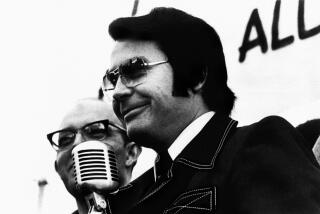Tokyo Still on Alert in Wake of Guru’s Arrest
- Share via
TOKYO — Tens of thousands of security police were on alert Tuesday as Japan braced itself against possible retaliation for the arrest of Aum Supreme Truth leader Shoko Asahara on suspicion of murder in connection with a deadly poison gas attack in Tokyo subways.
Although the palpable anxiety here might have seemed extreme to some, a mysterious parcel bomb did explode at Tokyo City Hall, ripping the fingers of one hand off an aide to Gov. Yukio Aoshima just hours after Aoshima announced that he would seek to revoke the cult’s special tax-free status.
It was unclear whether Aoshima was being targeted by the cult in the latest mysterious act of violence that has spooked this land fabled for its residents’ sense of safety and security.
Prime Minister Tomiichi Murayama urged vigilance, saying it was still possible that sarin--the Nazi nerve gas authorities say was used in the subway attack--was secretly stockpiled around Japan.
Murayama’s remark created further jitters here, since it appeared to contradict earlier police reports that no sarin remained that could be used for a counterattack.
Indeed, commentators said the climactic arrest of Asahara--staged early Tuesday amid heavy morning fog with 2,000 police--had not begun to unravel the mysteries still shrouding the cult, as had been promised. Nor has it shed light on numerous suspicious incidents that have plagued Japan, including at least five other gassing cases, two kidnapings, an attempt on the national police chief’s life and the slaying of the cult’s chemical chief.
“The more you report, the less you understand,” said Hiroshi Kume, newscaster for TV Asahi network.
In the first link to a previous unsolved sarin attack, the Yomiuri and Sankei newspapers reported today that a Supreme Truth chemical expert has confessed to making the poison gas for the attack in Matsumoto city northwest of Tokyo last year.
Masami Tsuchiya, 30, reportedly told police that he was ordered to make the sarin by Hideo Murai, the cult’s chemical chief, who was fatally stabbed in April. “Let’s test it out in Matsumoto,” Murai allegedly told Tsuchiya, the newspapers reported.
Tsuchiya had previously told police that he made sarin four times and delivered it to unnamed cult officials just before the March 20 Tokyo subway attack, which killed 12 people and sickened 5,500. The Matsumoto attack killed seven people and injured more than 580 others.
But the guru--who was nabbed from a secret room in the group’s Mt. Fuji compound while meditating--reportedly declared his innocence.
“How could a blind person like me cause such an incident?” he reportedly told police.
Saying “even my followers don’t touch me,” he refused a check of his pulse and told officers that he was healthy, despite the cult’s insistence that Asahara was bedridden and could not survive outside the Mt. Fuji compound.
Asahara’s arrest was officially announced by Yukihiko Inoue, head of the Tokyo Metropolitan Police Department, who gave a rare news conference to answer questions about the case. Virtually all other information on this case has been leaked to an exclusive club of Japanese police reporters; the club is difficult for foreign reporters to enter.
If convicted of the subway murders, Asahara could receive the death penalty. But commentators questioned whether authorities will manage to extract a confession from him--something without which prosecutors tend to be reluctant to press capital cases.
Asahara’s arrest has not prompted any mass suicides, as some had feared, but mysterious incidents have begun to crop up.
The parcel bomb exploded around 7 p.m. Tuesday, when Aoshima’s executive secretary, Masaaki Utsumi, opened a book addressed to the governor. Utsumi lost several fingers on one hand but was in stable condition.
“I saw white smoke rising and [Utsumi] was staggering with his hands down, with his face and chest covered with blood,” said Fujie Kikuchi, 61.
On Monday, mysterious fumes were detected in New Yokohama station in the port city of Yokohama near Tokyo, sending two people to the hospital. And over the weekend, 30 vinyl balloons--one marked with the March 20 date of the subway attack--floated into Japan.
Police on Tuesday also spoke of their investigation into whether Supreme Truth had transformed its Mt. Fuji compound into a methamphetamine production center--and sold the stimulants to the Yamaguchi-gumi, Japan’s largest organized crime syndicate.
Some commentators have speculated that the slaying of Murai, the cult’s chemical chief, was related to such illicit activity, because the two men arrested in connection with the killing are affiliated with the Yamaguchi-gumi.
By apprehending 27 of the 41 followers named in arrest warrants, police have managed to sweep the streets of many of the cult’s top leaders.
Under the Japanese justice system, criminal suspects may be detained and questioned without an attorney present for up to 22 days. And police routinely extend that period by rearresting suspects on different charges.
But commentators noted that 14 wanted members remained at large, and they urged caution.
In other developments, officials removed 44 more children from various cult facilities on grounds that their welfare was endangered, bringing the total to 77. It is unclear what will happen to the youngsters.
More to Read
Sign up for Essential California
The most important California stories and recommendations in your inbox every morning.
You may occasionally receive promotional content from the Los Angeles Times.













